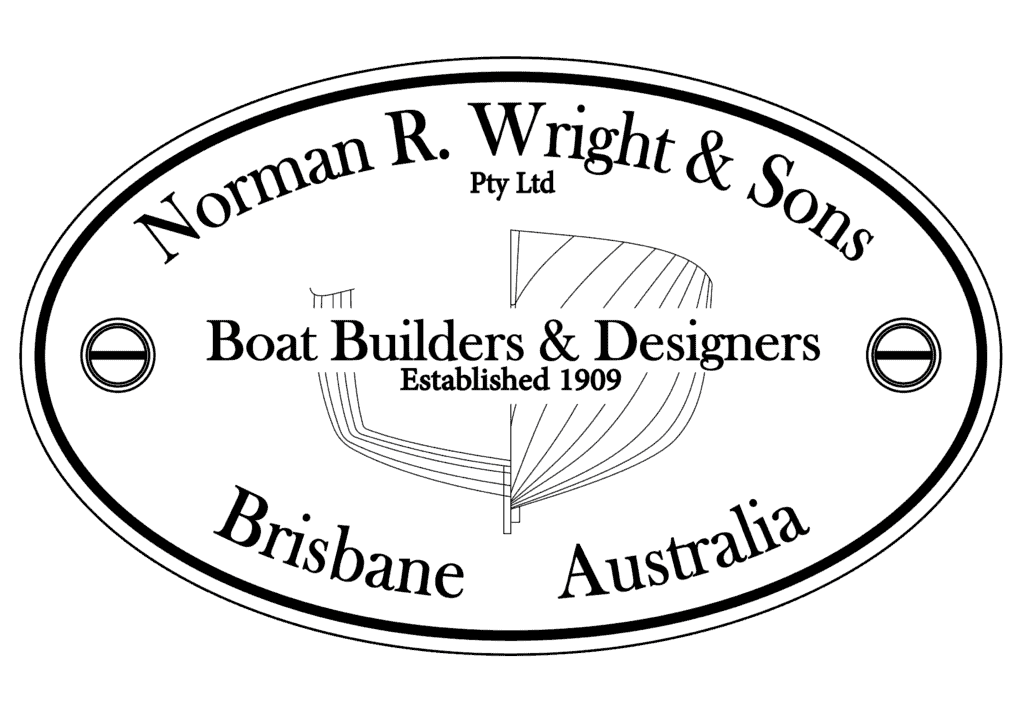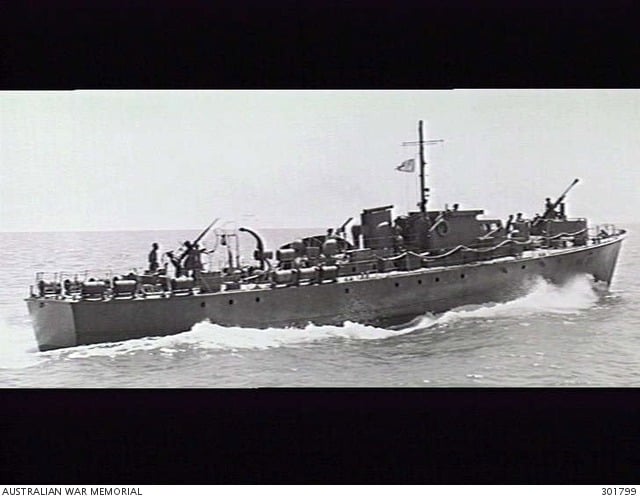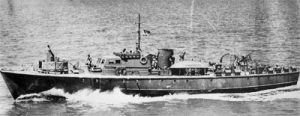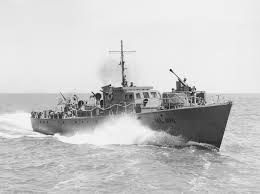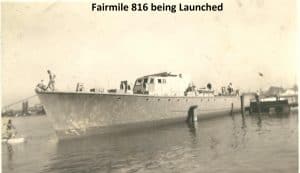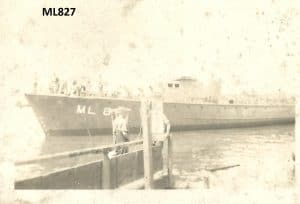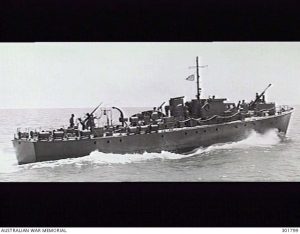After the entry of Japan into World War II there was an urgent need for Australia to have a small, basic, multi-purpose vessel. This vessel would have to undertake such tasks as convoy escorts, submarine hunting, patrols and special operations like delivering Commandos & Coastwatchers to nearby Pacific Islands. The Australian Government Department of Defence selected the Fairmile Type B motor launch to fulfil these various duties.
The Fairmile Type B featured the following dimensions:
| Length | 112 feet |
| Beam | 18’4” wide |
| Draft | 4’9” |
| Displacement Light | 70 tonne |
| Displacement Loaded | 89 tonne |
The Fairmile was a round bilge design built in timber. The planking of the Wright & Halvorsen build was double diagonal in Oregon with a total thickness of 1 1/16th. The keel was 8”x 8” hardwood while the frames were 1 inch think bonded plywood notched out to receive 3” x 1 1/5” stringers. Everything was very light.
The background to the Fairmiles is interesting. They were designed in the UK by W.J. Holt and loosely based on a small destroyer design. The idea was to have pre-fabricated frames that could be assembled on the keel backbone with semi-skilled labour. The Australian Government liked this idea and agreed that a company called Concrete Constructions would commence build of 20 Fairmiles from pre-fabricated parts supplied by The Admiralty.
The Fairmiles were called the Green Point Boats and were cheaply built using hooped pine and brass fastening. They were definitely built for the short term and by semi-skilled trades.
At the same time, the Department of Defence entered into negotiations with Norman R Wright & Sons and Halvorsens, with both companies initially given 2 boat orders. The difference was both Wrights and Halvorsen were going to build the boats from scratch, no pre-fab parts, with much better quality materials used overall.
Wrights sourced Oregon planking and Beech decking from local suppliers Bretts, who remain in business today. The fastenings used were silicon bronze and lead paint used on the canvas lining material between the double diagonal planking.
By comparison, the Green Point Boats used brass fastening & Linseed Oil on the canvas lining, there were many other differences between the Green Point Boats and the custom Wrights & Halvorsen builds, and I think you know where this story is going.
The engines were twin 650HP Hall-Scott engines which gave the boats a top speed of 17-18 knots. The UK Fairmiles always claimed a speed of 20 knots!! The range of the Wright & Halvorsen boats was 900 nautical miles at 12 knots (more about this later). The armaments included:
- 1 x two pound MKXIV Gun,
- 1 x 20mm Oerlikon cannon,
- 1 x 4 barrel 303 Vickers machine gun,
- 1 x Y Gun,
- 14 depth charges,
- 2 x Lewis Machine guns,
- 3 rifles and,
- 24 Grenades.
During the war most of the 2 pound guns were replaced with a Bofors gun and they added 2 x 50 calibre machine guns, usually borrowed off the US PT Boats. Resulting in plenty of firepower for these little ships.
The Fairmiles proved to be very handy at their designed roles. Along with 16 crew including 2 Officers, and the armaments, they were equipped with ASDIC for anti submarine warfare. Their role also diversified to additional tasks such as troop transport, air-sea rescue, boom defence, and attacks on maritime and shore defences in conjunction with the American ELCO PT Boats, that we’ve written about before.
The Fairmiles were known for not having the best behaviours at sea, they rolled heavily in a beam sea and had a tendency to broach in a following sea. They also leaked through their deck, particularly the Green Point boats. Dad always maintained the double Beech deck on our boats did NOT leak! All up 35 Fairmile boats were built in Australia and two were lost during the time of the war.
This story is about the Norman Wright built Fairmiles 815, 816, 826 and 827 (the final Fairmile built in Austrailia during the World War).
Summary of the Norman R. Wright & Sons Fairmiles:
| 815 | Commissioned 16/11/1942 | 8 month build | Survived World War II |
| 816 | Commissioned 2/6/1943 | 12 month build | Survived World War II |
| 826 | Commissioned 1/1/1944 | 12 month build | Survived World War II |
| 627 | Commissioned 19/4/1944 | 12 month build | Sank 20/11/1944 |
The Navy supplied a full set of drawings for the building of the NRW Fairmiles, with the original drawings and all records of the construction of the 4 boats are still in our archives today.
Uncle Norm was given the job of lofting the Fairmiles in the Quay street top loft. The loft was only 100 foot long so Norm overlapped the lofting so as to fit the 112 foot builds. (Much the same as what brother Ian did when he lofted Elizabeth EII in 1981). Norm found himself in a fair amount of trouble with the Navy after he called the shape of the sections of the Fairmiles as a copy of a “Piss Pott” to use his own words. The sections really did resemble the china ornament that adorned most bedrooms of the era.
Norm was hauled up before the Naval Command for salacious talk, he then explained the problem of slack round bilges in seakeeping and asked why the Navy didn’t look at the German E Boats and copy the design of their tight bilge? He was ordered to keep quiet and keep his opinions to himself.
Fairmiles 815
ML815 was the first NRW Fairmile to go north and served with great distinction from it’s base in Darwin. During commissioning she was found to be slower than the contemporary Fairmiles in Europe, reason being, Dad had redesigned the propellor. The original Fairmile was designed to use a 35” x 35” prop, Dad designed a 38” x 30” prop that whilst slower at top speed (1900rpm), when at (1400rpm) would be 1 knot faster than the others. This gave the Wright & later the Halvorsen Fairmiles far greater range at cruising speed. This was critical when undertaking convoys or long range patrols.
Another interesting story while handing over the ML815 was the arrival of the CB (Confidential Books – Codes) from the Navy office which were securely locked in the wheelhouse. This was done by Dad under the watchful eye of Lieutenant Charles Inman (RANVR). Dad handed the keys to Lt Inman with ML815 to depart the next day. The following morning the wheelhouse was opened up to find the CB box was missing. The Navy office immediately closed and secured the NRW compound while RAN and US Military Police searched the area. A Captain from the Royal Navy arrived to conduct an enquiry of all NRW employees and the entire crew of ML815. Nothing was found and the crew and all NRW employees were clear.
After 2 days of further investigation a Japanese cell was discovered operating out of Hamilton Hill, and they became the chief suspects. At the same time a team of US Navy Divers were employed to sweep the bottom of the river around ML815, searching everywhere except directly under the boat. In desperation the Divers were sent back into the river to examine under the boat, where surprisingly they found the CB box resting on the bottom and attached to a line with a Stokers Hitch knot. The investigation returned to the crew. While not finding the culprit, the crew were changed and no more trouble was to be had for ML815.
ML815 conducted many patrols out of Darwin including a very important mission escorting a submarine carrying the “Japanese Z Plan” from an aircraft downed in the Philippines. The US submarine “Crevalle” transported the Cypher’s and 28 women and children to Darwin where it was met and escorted into Darwin by ML815. Japanese Cypher’s were still being used by the Japanese Government until November 1944, an incredibly crucial tool for the Allies to have.
ML815 also rescued and recovered many downed airmen during the war, then after the war was auctioned off in Fremantle in 1947. She then sailed across the Great Australian Bight to Sydney under the name of Ocean Cruiser eventually being sold to Mr R Wood of Auckland New Zealand where she finished her life in 1971.
Fairmiles 816
ML816 was commissioned on the 2nd of June 1943 under the command of Lieutenant Ken McLaren RANR. Her first major job was to escort the HMAS Koopa (Koopa did the ferry run from Brisbane to Sandgate/Redcliffe & Bribie prior to WWII) to New Guinea. The “Koopa” was to act as the Fairmile’s mothership once established in Milne Bay.
During this trip north, the convoy gained a number of Liberty ships towing the ELCO PT boats as they didn’t have the range to get to PNG. From Milne Bay, ML816 proceeded to Buna and onto Morobe where it operated with the
USN ELCO PT boats against Japanese small ships, landing craft and shore installations. Typically the patrol would consist of 2 RAN Fairmiles and 2 USN ELCO PT boats, starting late in the afternoon following a route to Finschhafen
through the Vitiaz Strait to New Britain, returning to their base by sun-up the next morning.
ML816 and 424 were the first boats into Madang after the Australian Army conquered the Japanese in the area. The Fairmiles including 816 then set up base in Madang and operated against shore based Japanese strongholds and
island based garrisons in the surrounding area. During one of the raids on Hansa Bay some of the ship’s company captured a Japanese heavy machine gun and ammunition, which was quickly mounted on ML816 as additional firepower, and stayed in place until ML816 returned to Sydney for refitting.
ML816 had seen extensive service in PNG so the refit was long overdue and well deserved. On the way to Sydney she stopped in Cooktown to refuel and restore, with an RAAF band greeting them on arrival. After much drinking and carousing with the locals the crew liberated the RAAF band of most of their instruments and placed them securely aboard, departing soon after for Sydney. On arrival into Sydney the crew were met by a very unhappy Naval Officer demanding the immediate return of the instruments, which happened promptly and the offending crew members having their leave cancelled.
On return to duty, ML816 became a member of the Wewake Offensive Action in PNG and was the senior ML member of the campaign, once again seeing a lot of action against barges and land strong holds. At one point she was attacked by enemy aircraft and managed to damage one. On the night of the 30th of April 1945 ML826 and ML804 entered Wewak Harbour and shelled Wewak Point from 1,000 metres, shelling other positions before returning to the relative safety of the outside sea. ML816 then followed up a daylight raid with 804, 820 and 808, steaming in
line at 14 knots and stealing?? all enemy positions that had been reported by the Australian Army spotters.
The force withdrew after 816 received heavy artillery firing with shells falling all around, and managing to not take a direct hit.
When the war was over, ML816 was sold at the Navy auctions in Brisbane in 1947 for 450 pounds. She was well and truly worn out and in poor condition. She was bought by Roylens Cruises and called “Greenie”, ultimately used
as a spares boat. When her time was done with Roylens she was again sold, and after that we don’t know what became of her.
Fairmile 826
Commissioned 1st of January, 1944 under the command of Sub-Lieutenant Noel Spicer RANVR.
ML 826 departed Sydney on February 13, 1944 bound for Fremantle where she was to be based for the remainder of World War II. The trip across the Great Australian Bight through to Albany was extremely rough. On arrival in Fremantle she was joined by ML815, which had sailed down from Darwin. Most of her time was spent undertaking air-sea rescue and exercises with midget submarines of SRD “Z” Force, based at Garden Island off Rockingham.
She completed her war quietly in Fremantle and was in very good condition. The Navy eventually sold her off to the McGann Brothers of Perth for a ferry service. In 1964 she changed hands again and the Hunt Family purchased and named her “Rottnest Islander” with her primary role transporting tourists to and from Rottnest Island in WA, continuing her service until well into the 70’s. After leaving the ferry service she was renamed “Princess Royale” where she operated out of Royal Harbour in Albany doing whale watching tours. In 1984 she returned to Perth to be laid up almost 40 years to the day after her launch.
Fairmile 827
Commissioned on the 19th of April 1944 under the command of Lieutenant Commander Clarke Inman RANVR, ML827 was the last of the Fairmiles built in Australia during World War II, experiencing a short but eventful life.
On commissioning, ML827 made her way directly to PNG where she was based in Madang Harbour. Ian Downs joined ML827 as Commanding Officer having previously worked as a CoastWatcher. Ian recounted this story in the book “Fairmiles Ships Of The RAN”. In the wardroom of ML827 he met the Commander of a USN LCI (Landing Craft Infantry), with the American CO looking for alcohol. The Australian crew always had a small pool of liquor that they used with the CO proceeding to barter for the items they wanted and according to unofficial transcripts of the conversation.
| US CO | “Scotch $50 or this watch” |
| AUS CO | “No way, we don’t sell Scotch” |
| US CO | “Corio” |
| AUS CO | “Good god no” |
| US CO | “Rum” |
| AUS CO | “No” |
| US CO | “What do you want, I’ll give you anything you want!” |
| AUS CO | “Anything?” |
| US CO | “Anything within reason” |
| AUS CO | “You are from the LCI that has an anti-aircraft gun aft that does some sort of gyro controlled arm off sight” |
| US CO | “We sure do” |
| AUS CO | “Good, we need a mounting plate, the tripod, the feeder belts and your ammunition boxes. The mechanic who burns the plate of your deck has to help fit it to our deck. When can you start!!” |
| US CO | “Two bottles first” |
| AUS CO | “When can you start” |
| US CO | “In 5 minutes, lets have the scotch” |
| AUS CO | “1 bottle on delivery of the gun and 1 bottle when bolted on the deck” |
Before sunrise the next day the new AA Gun had been mounted aft on ML827
just below the of the aft Bofors Gun. It seemd the USN had no issue with losing
gear as long as it ended up in an operational area.
ML827 undertook many patrols along the coast and around Hansa Harbour.
The patrol usually included another ML boat and 2 PT boats but the 826 engines
started to become very unreliable. Two new 625HP Hall-Scott engines were
requested and arrived at Madang; problem was they were both starboard engines
so we were fine if we wanted to go round in circles but that’s not how things
operated.
The Americans came to our aid once again, they had 2 spare Packard
1200HP engines from the PT boats they offered and the crew of ML827 were
delighted. They fitted the engines and naturally found they could go faster but
used a great amount of fuel.
The Americans decided that ML827 would become a permanent anti-submarine
escort for a big fuel tanker called “Rio Grande”. The two vessels travelled
everywhere together, when in harbour the ML827 could bunk in “Rio Grande” in
comfort using the mess facilities and great food on offer. But sadly this
wasn’t to last as ML827 was called out for anti-submarine and anti-barge
patrols in Japanese held Jacquinot Bay and Rabaul. That night the young Sub
Lieutenant in charge of watchkeeping was having a lot of trouble with the
navigation courses laid out due to magnetic disturbance in the area, which in
turn was distorting the magnetic compass.
The ML827 entered a patrol area of Wide Bay when the ship suddenly
bumped on the bottom several times. The bow rose and she became hard and fast
on the coral. The CO ordered full astern but nothing was moving. The crew then
jettisoned everything possible including 14 depth charges which were set to safe
before rolling them over the side. Unfortunately she was still set hard and
fast on the coral reef.
In the morning ML802 attended to assist with towing, but 827 would still
not budge. A bigger vessel was needed and the American rescue vessel the
“Cambrian Salvor” arrived passing a large to rope to 827. “Cambrian Salvor”
then proceeded to pull ML827 from the reef, and once floating and free, most of
the crew were transferred to the rescue ship. The 2 vessels then proceeded
towards Finschhafen with the “Cambrian Salvor” proceeding at such speed the 827
became unstable. 827 requested the rescue ship to slow down, which was denied,
and then shortly after 827 capsized and sank.
Luckily all crew were rescued but an unfortunate end for such a great
boat.
